#ike gyokuran
Photo

Ike Gyokuran | Autumnal Landscape with a Waterfall, second half of the 18th century #womenartists (at Buchanhaven Pierie) https://www.instagram.com/p/CqUl_dBo0l-/?igshid=NGJjMDIxMWI=
1 note
·
View note
Text

Autumnal Landscape with a Waterfall - Ike Gyokuran (18th century)
4 notes
·
View notes
Photo


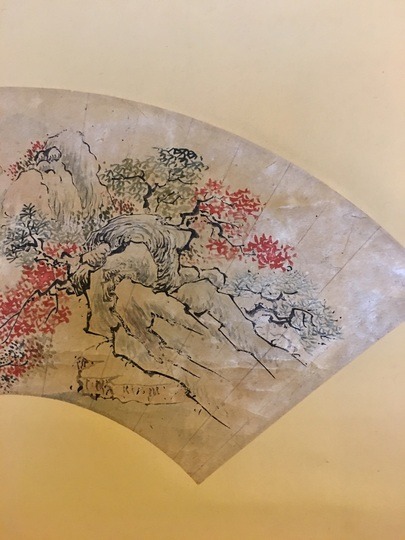



kakemono 掛物 - “Autumnal Landscape”, de
Ike Gyokuran 池玉瀾 (1727–1784)
Femme artiste épouse de Ike noTaiga 池大雅 (1723–1776)
Ike noTaiga et son épouse Tokuyama Gyokuran 徳山玉瀾 étaient des artistes prééminents du XVIIIe siècle.
#ike gyokuran#tokuyama gyokuran#female artist#painter#painting#hanging scroll#fan#japan#femme peintre#peinture#kakemono#japon
60 notes
·
View notes
Photo

https://store.philamuseum.org/400100011461/ike-taiga-and-tokuyama-gyokuran-japanese-masters-of-the-brush
“Ike Taiga (1723–1776) and his wife, Tokuyama Gyokuran (1727–1784), were preeminent artists in eighteenth-century Japan. This landmark book—the only comprehensive survey available in English—focuses on the lives and times of these artists and accompanies the first-ever exhibition devoted to their work in the United States.
Considered by contemporaries to be an eccentric marvel, indifferent to worldly preoccupations, Taiga is best known as a pioneer of the so-called Nanga style, which emulated Chinese literati painting. He was hugely prolific and experimental, working in an impressive range of styles, techniques, compositions, and subjects to produce more than one thousand calligraphies and paintings, and many large-scale fusuma (sliding doors) and screens. While not as well known as her husband, Gyokuran was a significant artist and a well-regarded poet of Japanese verse. Taiga wrote poetry in Chinese as well as Japanese, and translated poems by both artists are featured prominently in this volume. “
35 notes
·
View notes
Text
Chapter 95-1 Thoughts
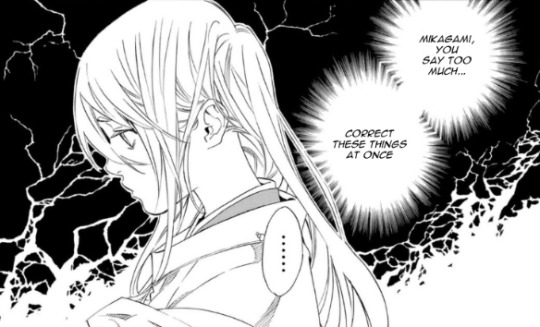
(opens door) Hey guys, welcome back to my channel blog.
I have quite a lot of thoughts this time so I’m posting them on here as well! This was originally a Twitter thread so if you wanna see all the panels that go along with what I’m discussing, you can head over to @kanotototori at Twitter (because I’m pretty sure that many images would crash the website on my and you guys’ end LOL).
Without further ado, let’s begin.
First off, the poem.

As some of you may know, I was at work when the translation dropped so a fellow theorist from a Discord server already beat me to finding this poem and what it references.
This is a poem from the Kokin Wakashu, a collection of poetry dating from the Heian period, around 905 (matches up with our timeline!). It's said to have been composed by Kakinomoto no Hitomaru, who was a waka poet and aristocrat in the Asuka period (548 - 710).
Hitomaru was said to have died on Kamoshima Island, located off the coast of Masuda city. The island is a bit of a legend as it does not actually exist today - the island sunk into the ocean during an earthquake and tsunami in the Middle Ages. It looks similar to the diagram of Tamatsuki we got in a previous chapter. (Kamoshima on top, Tamatsuki on bottom).
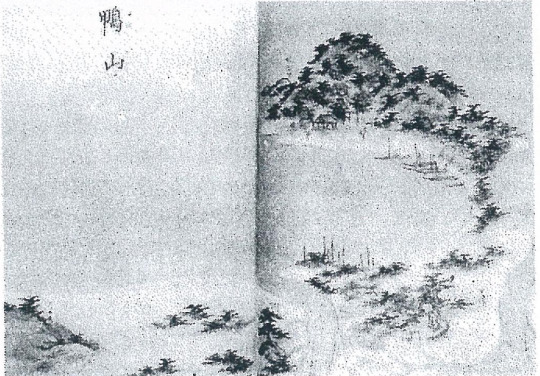
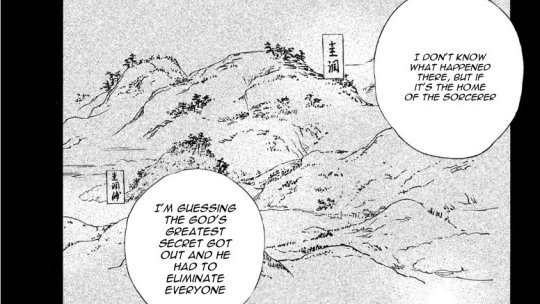
As for Akashi Bay... it seems likely that it's the Akashi Bay located in modern-day Hyogo prefecture . A page on the works of Ike Gyokuran states that Akashi Bay was a famous fishing village. This is the artwork depicting it - again, very similar in vibes.

Also, also. The fact that this island is invisible unless very specific conditions are met is like, very worrying to me as someone who is a longtime fan of Japanese horror based on traditional ghost stories.
I swear, every time a location is hidden in a blind spot in this manner, it tends to be off the wall CURSED. All caps CURSED. Usually involving the party unfortunate enough to end up there being stuck until they can find a way out - it's akin to literally being in another dimension. I don't like this.
Also, a friend pointed out that the island looks a bit like a torii gate. Torii gates mark off the outside, "mundane" world from the scared (or, in this case, probably cursed) so very appropriate. I've also seen them used as a sort of entrance to places that hide in "blind spots" such as Tamatsuki. Speaking of... what the hell could be on that island? I'm squinting REALLY hard guys and I'm not seeing anything. Anyway, please Adachitoka show us the LOOOORE.
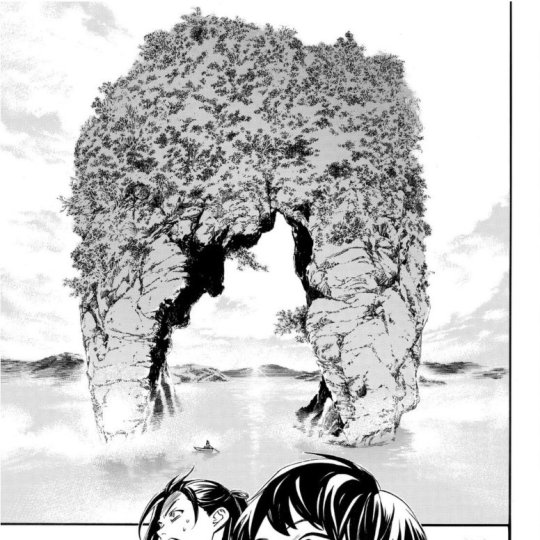
[Page: “The sound of taiko drums split the sky. Everyone simply wishes to exist in peace. So why has it come to this...?”]
This is REALLY interesting and I'm gonna zoom in on the "Everyone simply wishes to exist in peace so why has it comes to this...?" before I zoom in Amatearsu herself. This is INCREDIBLY ironic considering that Heaven's form of "peace" looks more like straight up oppression. Yes, everyone wishes to exist in peace. But as we have seen, Heaven's "peace" and harmony is not about simply existing but about the explicit absence of "discord" and dissent.
One only needs to look at what Heaven did to the Emishi or hell, even with the statement that anyone who defies Heaven dies - it's not about purposefully causing harm like Father but simply even defying the system in power. There is absolutely no ambiguity there. That is not peace but it says a lot that Amaterasu seems to think that it is.
[Page: Amaterasu feeling the net on her.]
Do I even need to say why this is really really REALLY bad? The net Amatearsu is feeling on her is very likely Hagusa's net, seeing as they know about it and explicitly cite it as a "net that makes mockery of Heaven's net."
This is incredibly interesting because Hagusa's net is mostly meant to motivate people to act and not pass judgement or trap gods but a friend of mine brought up an interesting point: does Yukine seek to judge Amaterasu and the other gods? Hagusa's net encourages people to act, yes, but explicitly against those who people perceive to have done something wrong. He literally said that gods don't punish evildoers + Yuka's quote about everyone who stood by and watched deserving Yukine's judgement... I do wonder... hmm.... Father/Yukine parallel brain rn.
I feel like it is very important to make a distinction between Amaterasu the goddess, Amaterasu-oomikami as the embodiment of Heaven, and Heaven itself.
As some of you may know, Japan had a pretty big chunk of history where the emperors were nothing more than figureheads for people in power. While I don't think that is ENTIRELY true for Amaterasu (but the Sacred Treasures do be looking sus... I suspect they might be pressuring her), she seems to be constrained by her role.
We saw Amaterasu as Amaterasu-oomikami, embodiment of Heaven, during Heaven arc. She is expected to uphold and sustain the laws of Heaven and all its mentalities (Heaven is always just, human laws do not bind them) as a system; her personal desires and feelings do not come into consideration here.
We see even here that her personal feelings as Amaterasu the goddess are at war with what is happening.
This makes me think back to the Yomi name-call scene where Amatearasu comes down to the squad to tell them how to get Yato and Bishamon out from Yomi. Many cite this scene as evidence of the Tsukuyomi theory. However, Amaterasu says it plainly: she's there because she wants to be, having told no one she's there because the Heavens cannot bow to anyone.

Again, distinction between Amaterasu the goddess (who is there because she wants to be) and Amatearsu-oomikami, ruler of Heaven, embodiment of their principles.
[Page: “Heaven has missed things like it has not kept watch at all. Now it is as though we must find someone to punish...”]
Jesus, Heaven really IS more concerned with keeping up appearances and protecting their pride rather than doing anything useful or helpful. It's really no wonder Father described it all as "getting dragged into [their] arrogance." Because it absolutely is arrogant.
[Page: “I took care of you, I gave you food and a roof over your head...” “I’ll kill you, you ungrateful brat!”]
Yes, I'm gonna say the obvious: this totally reeks of entitlement. It's all very "I gave birth to you, I fed you, I put clothes on your back, so you must listen to what *I* say" that's so very reminiscent of real life parental relationships. That's the obvious part.
Now for something a little more tin foil hat-y: a friend brought up how it's very interesting that Father specifically pointed out that he clothed and fed Yato. Yato is a god and while he needs clothes (...arguably), he doesn't really need food. How Father continues to frame his relationship with Yato as "taking care" of him, providing for his material needs, everything that paints his relationship to him in such a parental light continually plays into this whole theme of "playing family." Dysfunctional, but with feeling (of some sort).
(I've already gone on at length several times about the whole "playing family" thing with them, Bishamon/her shinki, and Daikoku/Kofuku/Daigo so I won't go into it.)
Actually, I find how Bishamon talks about her shinki at times to be veeeery similar in this type of "ownership" of children. Not 1:1 with Father but on the same wave.
That constant barrage of "they were MY precious children", " why did you take them away from ME" is all very... less about her shinki and more about her and what their loss has done to her personally. Father seems to be very McProjecting about Bishamon playing family as well, cuz he's doing the exact same thing. Dysfunctional... but with feeling. Often misguided feeling.
So yeah, on one hand, I can see where Father is coming from. Not like he was #1 Dad in the world (obviously) but he did spend over a millennia providing for Yato and, in his mind, protecting him and caring for him. Emotions are running high, I imagine he feels quite slighted.
On an even more tin foil hat-y note: this makes me wonder about Father's own material situation when he was younger. Heian period Japan wasn't exactly kind to people who weren't nobility. It would make sense why Father would place providing materially as pretty high on the "why the hell are you being ungrateful" list.
[Page: “The cracks are deepening. Awakening all manner of unrest... it continues unabated. In anger we sometimes forget that which we should not. We must always remember that which is important...!”]
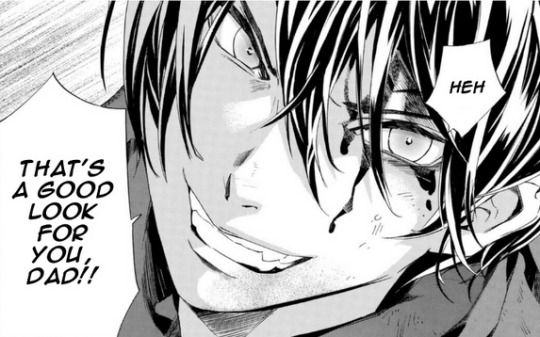
And finally, the last page (with that other page because it's a great continuation).
Let's face it: Yato has completely lost sight of the objective and is now toying with Father. This is really bad not only on an immediate "Ooharai is coming, oh shit" level but also on a thematic and maybe even moral level.
He could have gone for the killing blow on the first page, he went for the shoulder and Father's face. He could have gone for the killing blow in the page after, he went for the shoulder. Yato is toying with his prey, which is not something that we've seen him do before and outside of what Father has taught him so far.
(Obligatory "killing is bad, what Father taught him isn't good, please don't think I'm defending him" message before I say the next part.)
What Father has taught Yato is pretty straightforward: kill them, and don't listen to their pleas for their lives. Never once did we see Yato hold off on killing someone to cause them more pain before death when he had the opportunity (partly because he didn't want to in the first place but that's not so important).
Like I said in earlier tweet, Yato's anger at Father for his abuse is justified but so is Father's anger at Heaven for what they did to him. If we have two characters in a situation whose anger is justified then all that's left to judge is their actions, which is exactly where Yato and Father have differed until now and exactly where Yato is drawing VEEERY close to Father right now.
Father has long amused himself with Heaven's torment (and Yato's, in a slightly different sense) for what they've done to him and, likewise, Yukine is out to not only kill his father but also to make him suffer as he did. This is all portrayed as a quick slope downward and Pretty Fucking Bad universally.
Yato started this fight with the intention to kill Father quickly and save Yukine (GOOD). Yato is ending this fight completely setting those things to the wayside for the enjoyment of watching Father squirm (REALLY BAD). Does anyone even remember Yukine here anymore?!
Like Father, like Yukine, Yato is letting anger and revenge lead him. This only perpetuates the cycle instead of ending it.
"In anger we sometimes forget that which we should not. We must always remember that which is important...!"
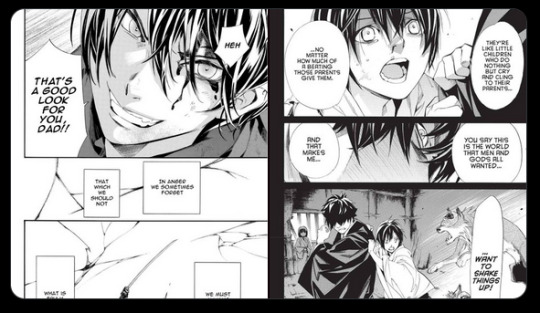
Thanks for coming to my TED Talk.
#me seeing people cheering yato on in the last page: WAKE UP SHEEPLE WAKE UP#noragami#my chapter thoughts#95-1#long post
113 notes
·
View notes
Photo

Akashi Bay, Ike Gyokuran, late 18th century, Minneapolis Institute of Art: Japanese and Korean Art
fan with minimal landscape scene; three horizontal banks with trees; three faint, small boats URQ; wispy calligraphy L half; signature LRC, stamps center R and LRC Gyokuran depicts a Japanese scene, one that she likely observed first-hand, rather than an idealized and imagined Chinese landscape. Her subject, Akashi Bay, is a well-known fishing village in present day Hyogo prefecture, best known for its octopus. This fan is typical of Gyokuran's oeuvre—small in format, and lacking in great drama, but rich in refinement, finesse and tranquility. Gyokuran follows a long tradition of combining text and image, but in using waka poetry for her inscription she further evolves literati painting along Japanese lines. The image dominates the right side of the fan, while the text is prominent on the lift, with a harmonious overlap in the middle. Each line of calligraphy is neatly ordered within a band of the fan between the bones, the text thus following the curve of the fan. In contrast the struts of land break away from this compositional device by jutting out at near perpendicular angles. The pine-covered strips of land are painted with a wet, flat brush, contrasting with the finer, more delicate and drier brushwork used for the inscription. The mood set by the poem is echoed in the painting. Using atmospheric perspective, Gyokuran depicts a poignant image of the loneliness of a cold autumn evening as distant fishing boats sail away, the suggestion of loved ones left behind.
Size: 8 1/2 × 17 1/2 in. (21.59 × 44.45 cm) (image)
Medium: Ink on paper sized with mica
https://collections.artsmia.org/art/116887/
11 notes
·
View notes
Text

Ike Gyokuran (1727–1784) Japanese Bunjinga painter, calligrapher, and poet.
6 notes
·
View notes
Text
"Potentiator" 2021-07-10
“Potentiator” 2021-07-10
(Track Permalink)
Creative Starting Point: a piece for 3 alto saxophones
Track art is made from the following historical public domain pieces:“Saxophone […] for Duke brand […]” (1888)“Peony and Bamboo” (ca. 1768) by Ike (Tokuyama) Gyokuran

View On WordPress
1 note
·
View note
Text
0 notes
Photo

by Ike Gyokuran, Asian Art
Medium: Fan mounted as a hanging scroll; ink and color on paper
The Harry G. C. Packard Collection of Asian Art, Gift of Harry G. C. Packard, and Purchase, Fletcher, Rogers, Harris Brisbane Dick, and Louis V. Bell Funds, Joseph Pulitzer Bequest, and The Annenberg Fund Inc. Gift, 1975 Metropolitan Museum of Art, New Yo
http://www.metmuseum.org/art/collection/search/48994
4 notes
·
View notes
Photo


Spring Landscape
Tokuyama Gyokuran was one of very few women included in the Edo period guide Who’s Who of Kyoto (Heian jinbutsu shi). She was noted for her composition of Japanese waka (poetry), but it was primarily her fame as an artist that merited her inclusion in the prestigious publication.This lovely landscape offers ample evidence of her skills. The pale blue-green of the willow trees forms the visual anchor of the composition as it zigzags over the lake and leads the eye to the bank of white plum blossoms before melting into the spring haze amid the rolling hills at top. The soft, supple brushwork and light application of the blue and pale salmon colors harmonize to create the spring atmosphere. Before entering the Museum’s collection, this scroll belonged to a woman artist living and working in Kyoto, Kajiwara Hisako (1896–1988). Source
52 notes
·
View notes
Photo

West Lake in Spring, Ike Gyokuran, 1750s-1770s, Minneapolis Institute of Art: Japanese and Korean Art
landscape in greens and browns; rugged mountain peaks; scattered trees; some small buildings; water at center with two boats with figures, including one boat with a canopy
Size: 21 1/4 × 39 in. (53.98 × 99.06 cm) (image) 62 3/4 × 46 5/16 in. (159.39 × 117.63 cm) (without roller)
Medium: Ink, color, and gold on silk
https://collections.artsmia.org/art/123451/
5 notes
·
View notes
Photo

Three Waka, Ike Gyokuran, second half 18th century, Minneapolis Institute of Art: Japanese and Korean Art
nine lines of delicate, wispy calligraphy; very short, two character line at LRC
Size: 6 5/16 × 17 1/16 in. (16.03 × 43.34 cm) (image) 36 7/8 × 20 13/16 in. (93.66 × 52.86 cm) (mount, without roller)
Medium: Ink on paper
https://collections.artsmia.org/art/117789/
2 notes
·
View notes
Photo

Two Autumn Poems, Ike Gyokuran, second half 18th century, Minneapolis Institute of Art: Japanese and Korean Art
six long lines of delicate calligraphy preceded by two shorter lines at R and LRC
Size: 6 1/4 × 15 5/8 in. (15.88 × 39.69 cm) (image) 36 13/16 × 16 11/16 in. (93.5 × 42.39 cm) (mount, without roller)
Medium: Ink on paper
https://collections.artsmia.org/art/117395/
2 notes
·
View notes
Photo

Chrysanthemums and Rock, Ike Gyokuran, 18th century, Minneapolis Institute of Art: Japanese and Korean Art
ink drawing of three chrysanthemum blossoms over an irregular scholar's rock Late blooming chrysanthemums, which often remain in flower during the first snowfalls of winter, are symbols of fortitude and resoluteness, and were a favorite subject for literati painters like Ike (née Tokuyama) Gyokuran and her husband, Ike Taiga. Her use of an angled brush—sometimes wet, sometimes very dry—captures the rough texture of an eroded rock, over which towers a chrysanthemum plant with three dramatic blossoms. The animated, well-balanced composition and abundance of curvilinear forms are characteristic of Gyokuran’s singular painting style.
Size: 41 × 11 1/4 in. (104.14 × 28.58 cm) (image) 77 × 18 1/8 in. (195.58 × 46.04 cm) (mount, without roller)
Medium: Ink on paper
https://collections.artsmia.org/art/40039/
1 note
·
View note